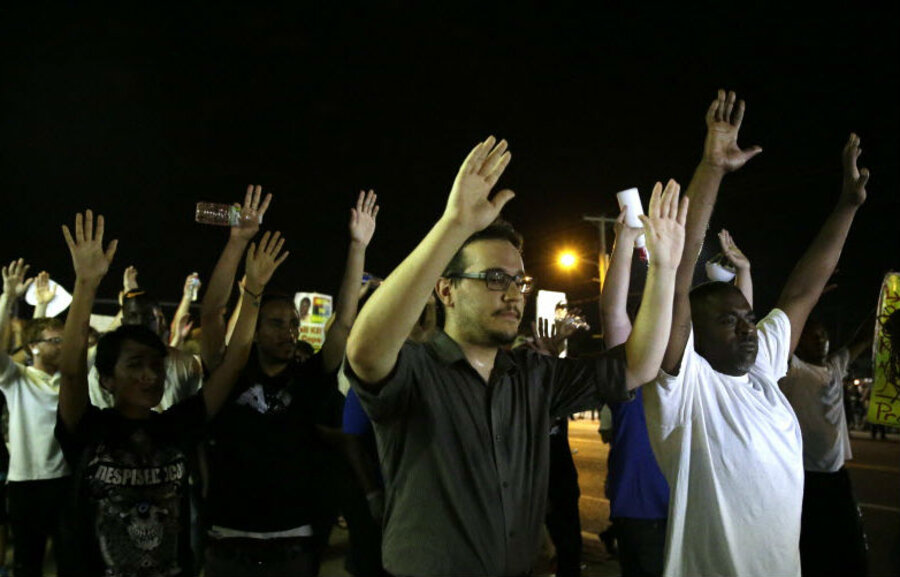A calmer night in Ferguson: Will the peace last?
Loading...
Protests in the racially tense suburb of Ferguson, Mo., took on a more peaceful tone Tuesday night, hours before a grand jury prepared Wednesday to take up the shooting death of unarmed teen Mike Brown.
The police still deployed pepper spray against demonstrators – but not tear gas and beanbag projectiles, as they had previously – and the protesters refrained from using live rounds and Molotov cocktails, as they did on Sunday and Monday.
While lively demonstrations sprang up throughout the evening, leading to 47 arrests, the crowds reportedly were smaller and largely limited to isolated groups of “agitators,” as they’re locally known. Many of those arrested reportedly came from outside the community, including some from organized, violent groups. One Austin, Texas, resident was detained for the third time by police.
According to Missouri Highway Patrol Cpt. Ron Johnson, a black Ferguson native who was put in charge of the police response on Aug. 14, Tuesday night represented a “turning point” for the city.
“Tonight, we saw a different dynamic,” Captain Johnson told The New York Times. “Protest crowds were a bit smaller, and they were out early. We had to respond to fewer incidents than the night before. There were no Molotov cocktails tonight. There were no shootings.”
He credited the calmer tone largely to religious and community leaders in Ferguson, many of whom marched with the protesters and implored residents to pursue justice for Mr. Brown in a nonviolent fashion.
“They had a calming influence on the younger people,” Johnson said.
Up until midnight, those calls for peace were almost unanimously heeded, as marchers put their hands up in the air – simulating what some witnesses have said were Brown's actions in his confrontation with officer Darren Wilson on Aug. 9. The demonstrators also held hands in prayer.
Only later did the evening’s confrontations begin, as isolated protesters threw urine and bottles at police. Authorities refrained from mass arrests, often entering crowds, detaining one individual, then exiting.
Still, some fear that the relative calm on the ground is just a respite. On Thursday, after Johnson and the Highway Patrol took over policing of the suburb, rioting and looting essentially ceased, as authorities replaced a heavily militarized response strategy with a conciliatory approach in which police officials walked with protesters.
Over the next few days, however, the situation deteriorated, and on Sunday, Gov. Jay Nixon (D) called in the National Guard in response to the attempt by protesters to overrun a police command post, firing live bullets and lobbing makeshift explosives at officers.
In an op-ed in the St. Louis Post-Dispatch, US Attorney General Eric Holder encouraged peace on the streets, while stressing the need to reform the way that police treat civilians, especially in divided communities like Ferguson.
“Enforcement priorities and arrest patterns must not lead to disparate treatment under the law, even if such treatment is unintended,” he wrote. “And police forces should reflect the diversity of the communities they serve.”
Mr. Holder plans to visit Ferguson later Wednesday, where he will meet with community leaders as well as both federal and county-level authorities, who are conducting their own, independent investigations into the shooting.
One of the local concerns he likely will be confronted with has to do with St. Louis County Prosecutor Bob McCulloch, who, Ferguson residents say, has close ties with local police.
Mr. McCulloch’s father, brother, mother, cousin, and uncle all worked for the St. Louis Police Department, they point out, and his father was killed in an altercation with a black suspect.
Governor Nixon has refused to recuse McCulloch, noting that there are methods to remove oneself from a case that do not involve an executive action from the governor’s office.
“There is a well established process by which prosecutors can recuse themselves from a pending investigation,” he said in a statement Tuesday. “Departing from this established process could unnecessarily inject uncertainty into this matter and potentially jeopardize the prosecution.”
A St. Louis County grand jury is set to begin considering on Wednesday whether or not Officer Wilson should be indicted in connection to the shooting death of Brown.
Material from The Associated Press was included in this report.







